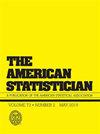Bayesian Inference and the Principle of Maximum Entropy
IF 2.1
4区 数学
Q1 STATISTICS & PROBABILITY
引用次数: 0
Abstract
Bayes’ theorem incorporates distinct types of information through the likelihood and prior. Direct observations of state variables enter the likelihood and modify posterior probabilities through consistent updating. Information in terms of expected values of state variables modify posterior probabilities by constraining prior probabilities to be consistent with the information. Constraints on the prior can be exact, limiting hypothetical frequency distributions to only those that satisfy the constraints, or be approximate, allowing residual deviations from the exact constraint to some degree of tolerance. When the model parameters and constraint tolerances are known, posterior probabilities follow directly from Bayes’ theorem. When parameters and tolerances are unknown a prior for them must be specified. When the system is close to statistical equilibrium the computation of posterior probabilities is simplified due to the concentration of the prior on the maximum entropy hypothesis. The relationship between maximum entropy reasoning and Bayes’ theorem from this point of view is that maximum entropy reasoning is a special case of Bayesian inference with a constrained entropy-favoring prior.贝叶斯推理与最大熵原理
贝叶斯定理通过似然和先验结合了不同类型的信息。状态变量的直接观测进入似然,并通过一致更新修正后验概率。以状态变量期望值表示的信息通过约束先验概率使其与信息一致来修改后验概率。对先验的约束可以是精确的,将假设的频率分布限制为仅满足约束的那些,或者是近似的,允许从精确约束到某种程度的容忍的剩余偏差。当模型参数和约束容限已知时,后验概率直接遵循贝叶斯定理。当参数和公差未知时,必须指定它们的先验。当系统接近统计平衡时,由于先验集中在最大熵假设上,后验概率的计算得到简化。从这个角度看,最大熵推理与贝叶斯定理的关系是,最大熵推理是贝叶斯推理的一种特殊情况,具有约束熵偏好先验。
本文章由计算机程序翻译,如有差异,请以英文原文为准。
求助全文
约1分钟内获得全文
求助全文
来源期刊

American Statistician
数学-统计学与概率论
CiteScore
3.50
自引率
5.60%
发文量
64
审稿时长
>12 weeks
期刊介绍:
Are you looking for general-interest articles about current national and international statistical problems and programs; interesting and fun articles of a general nature about statistics and its applications; or the teaching of statistics? Then you are looking for The American Statistician (TAS), published quarterly by the American Statistical Association. TAS contains timely articles organized into the following sections: Statistical Practice, General, Teacher''s Corner, History Corner, Interdisciplinary, Statistical Computing and Graphics, Reviews of Books and Teaching Materials, and Letters to the Editor.
 求助内容:
求助内容: 应助结果提醒方式:
应助结果提醒方式:


